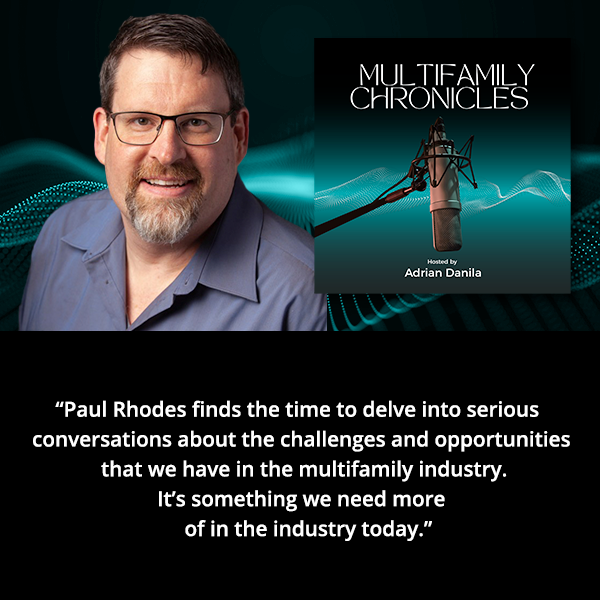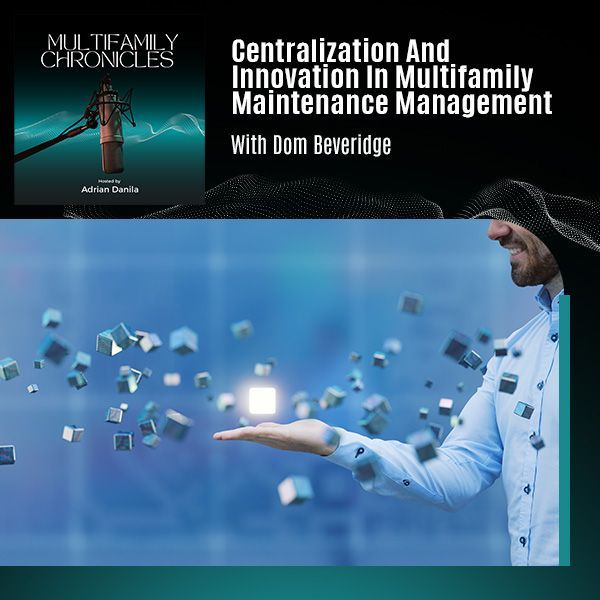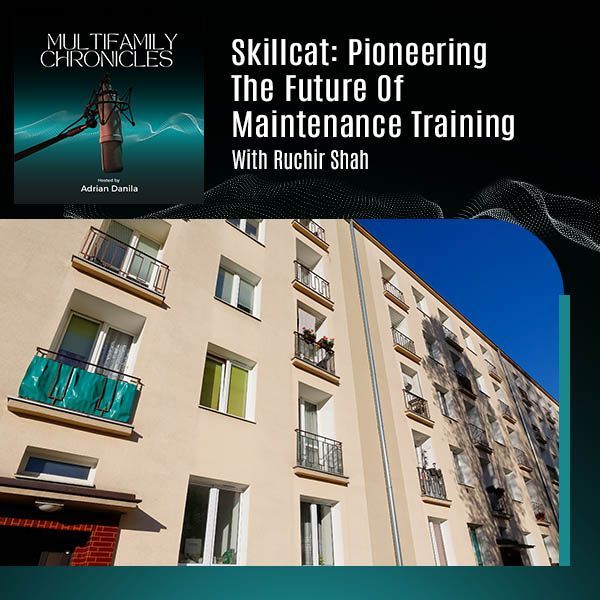Company Culture: Filtering Out The Challenges And Opportunities In The Multifamily Industry With Paul Rhodes
There is a saying that goes, “If you and I exchange an apple, we both have an apple. But if we exchange an idea, we have two different ideas.” That relationship created within a company creates an opportunity to grow. In this episode, Paul Rhodes, the Senior Manager of Maintenance Learning in Brookfield, shares how company culture filters the challenges and opportunities within the industry. Culture is made up of the relationship and the dynamic that occurs intentionally or accidentally between individuals. The intention is critical in building culture, but it is insufficient when there is inaction to it. Don’t miss this opportunity, and tune in now.
---
Watch the episode here
Listen to the podcast here
Company Culture: Filtering Out The Challenges And Opportunities In The Multifamily Industry With Paul Rhodes
In this episode as a guest, we have Paul Rhodes. He is a returning guest. This is the third time Paul comes on the show. Welcome back, Paul.
Adrian, thanks for having me again.
For a couple of people out there that don't know you yet, they haven't heard of you or who you are, you are a Senior Manager of Maintenance Learning with Brookfield Multifamily. Paul, I do want to start by defining company culture. This is a topic that you and I didn't have time to cover in the previous episodes. We wanted to but we didn't get to it.
I want to dedicate this episode and the next that we're going to report to company culture and how certain things are being affected by the culture or using culture, if you wish, as a filter for all the challenges and opportunities that we have in multifamily. Please, what's your definition of company culture? How would you see it? How would you define it?
Adrian, thanks again for having me on. It's always an honor to collaborate, talk and have a discussion about topics, whatever it happens to be. The topic of culture, especially if you're paying attention to LinkedIn or all the Insta, Facebook and the social stuff, is a big one where careers are concerned and companies. Everybody's trying to figure out what culture is. I appreciated one of your episodes with Jen Piccotti and Kara Rice. One of them stated they've stopped trying to look for normal because it seems to change regularly.

Culture's one of those topics that are such a popular, almost overused or too broad topic. Everybody wants to have it but it doesn't get defined down to the actionable level at boots on the ground, specifically for the multifamily industry and even to subdivide that even further, for maintenance technicians in the multifamily industry. It's a challenging one because I'm not even sure we are in the conversation with maintenance persons.
A lot of cultures in social media are talking about remote work, flexibility and work-life balance but all the conversations I'm seeing in social media and popular culture it seems are focused on office workers where you can work remotely. A lot of the conversations were interesting about dealing with the pandemic. People were able to take their laptops and work from home. A lot of efficiencies were done working from home.
In the maintenance world, we can't exactly plunge a toilet or replace a faucet remotely. That conversation is happening but I'm not sure that maintenance persons for whatever reason are being included in that conversation. As a part of that conversation, what does culture look like? To begin that definition, my working definition of culture is the feeling that surrounds the way decisions are made at your property, region and corporate level and how well those work together on a one-on-one daily.
What I wanted to say and point out and I'll ask if you agree or disagree with the statement is that whether you cultivate culture on purpose or you don't, the culture exists. The culture is there. It's a living thing. It happens day in and day out. Whether we wish or not, it's irrelevant. Culture exists. That's a true statement. Let's talk about culture on purpose. How do we create a culture on purpose? How do we create meaningful environments and cultures that mean something to people?
It seems like maintenance is not even part of the conversation. They are part of the culture though. They exist. How do we fix that? How do we overcome that challenge? How do we bring everybody to the table and create that inclusive type of environment culture where people feel like they're part of something? They're not only the other guys, the hired help or the secondhand citizens. How do we do that?
First of all, we have to begin exactly where you did. Understand that culture exists. Whether you want it to or not, it's there. Whenever any two people get together in the same room, there is a relationship between them. Like, hate, happiness or sadness, all of those things are there. As individuals in that relationship, we have to decide what that relationship or culture is going to be and what that meeting between two people to simplify it has to be.
If we take that to a bigger realm at a property or a community where you've got 5 or 6 people that are all together, whether they're intentional or not, there is a relationship. There is a dynamic that's happening between those people. The first thing to do to affect or move the needle on whatever that culture looks like is for everybody to agree that first of all, it exists. It’s like time. Whether you're paying attention to it or not, time continues to move. The seconds and minutes tick.
Time continues to move, whether you're paying attention to it or not.
Everything goes by and all of a sudden, you begin, look backward and say, “I have spent weeks, months or years doing whatever. I've accomplished this. The this that I've accomplished, is it what I set out to do or did it happen by accident?” Both accidental occurrences and intentional occurrences are valuable because those are the moments that have shaped us.
Culture is the same way. We can be intentional or accidental about it. In some of the best relationships in my life, I didn't set it out like, “I want to get to know that person because they look like somebody I want to get to know.” It was accidental, unintentional or whatever ways you think those two people came together.
My best friend and I get together as often as we can in the same room and argue about things but at the end of the day, we're still best friends. I develop more because he argues with me. He develops more because I argue with him. We respect each other enough to think about what the other person is saying from their viewpoint. Mark Vanderhoof is his name.
We didn't set out to meet each other. He lives in Dallas, Texas. I live in Atlanta, Georgia. It so happened that years ago, he accepted a job offer with HD Supply, became one of my trainers and developed into a friendship. We still talk on a weekly basis and influence each other. Whereas, we disagree as much as we agree on stuff. We accidentally came into each other's lives and yet, we're intentional about the fact that if I've got an idea, I want to bounce it off of somebody.
On our properties, if we say that a culture is important and that is the beginning point, then on one hand, we need to know what kind of culture we're looking for. It might be a mistake at a property to say, “This is exactly what we want. This culture inside this box is here. We want to be this thing and this thing only so that we only intentionally work towards that little definition of what is ideal at our property and community.”
We have to leave a little bit of room for those accidental things because the culture at a property and community is made up of going back to that simple definition. It's made up of the relationship and the dynamic that occurs intentionally or accidentally between those 2, 3, 4, 5 or 6 people. The beginning place is recognizing it does exist, recognizing that we have an effect on it and allowing a few accidents to intrude with the intent of always making the best of what those accidents are.
We need to define what type of effect we want to have on it and the intention.
That intention part is critical. On LinkedIn, a couple of books and even a couple of sessions or videos I've seen, people were trying to define happiness. How does one get to be happy? I'm a very big believer in that intent part. If I want to be happy and satisfied, I have to set my sights on that, not only as a goal but as a way of being. It’s a decision thing. Likewise at a property, if we want to have a good culture, recognize it exists and secondarily, intend or decide that it's going to be a good one. We then have to define what good looks like.
The intention is extremely critical but it's not sufficient. We have to act on our intention. Once we define what the intention is, what we want to get out of it or what we want it to look like, the next thing is how we take action. What needs to happen to have the desired result, outcome or culture? Any disagreement here? Do you agree?
No, I agree with you. We begin with intention but the intention to do something is the thought and directionality. Until you begin moving, in other words, until we begin doing, the intention is still theory. It's still in the cloud, so to speak. It's not performing any action. A good coworker and I have this continual sparring about Post-it Notes. The little Post-it Notes that we all end up having that we use.
We've seen them on the property. I'll confess, I have them. I just held one up but on a day-to-day working basis, I also confess I hate them because how many times from a maintenance standpoint does our office get a work order or a request from a resident for something that needs to be repaired? It gets written on a Post-it Note and then that Post-it Note sits on a desk, gets dropped, fallen or forgotten until 4:58 on Friday afternoon when it gets found. Suddenly, the service request appears in our service request system at 4:58 and yet, the original request was called in Tuesday at 3:00 in the afternoon and here we are about to go into a weekend.
The intention in this analogy is like the Post-it Note. It doesn't get fixed until it becomes an official notification to maintenance to pick up their tools and go fix whatever it is. It doesn't happen until it happens. To take this analogy further, don’t just write it somewhere. That does not do anybody any good and chances are the person who took that request thought they were doing a good thing. In essence, they were but they weren't taking action about it. They were only noting it and they felt good about doing something but the something they did had no result. There was no action behind it.
From Tuesday to Friday in this analogy, whatever it was that was broken never got fixed, which means intentional or not, that resident feels ignored. This goes along with that cultural analogy you were making. With that resident, culture is happening. The resident feels ignored and disregarded. Not only that but on the bigger scale of things, the work culture by only keeping it as an intention, our maintenance technician who is going to fix it is already behind the eight ball.
They're already in a bad situation because the resident answers the door with, “Where have you been?” Maintenance looks at their phone or work order and says, “I got this three minutes ago. I'm responding quickly.” The resident says, “I called on Tuesday. This whatever's been broken for four days.” That's an example of if we don't treat culture as an intention, then culture and those relationships are going to happen. How we recover and maintain those relationships is a part of our work life that we all have to be aware of.
If we don't treat culture as an intention, then culture will happen. Those relationships are going to happen.
I want to pick up on something that you said about your friendship with Mark, your debates and how the best ideas win. You didn't say it that way but then you prove him wrong, he proves you wrong and you both grow. This brings up a very important topic in regard to culture. It's having a culture where ideas are what's being debated and not people. In other words, it only has value if it comes from someone at the top.
The person that runs higher has the ultimate word or is always right. When it comes to culture, they're the ones to have the last word. They going to decide like, “This is how we're going to handle it.” There's a part of management that says, “I am in charge. I also have a responsibility to make sure,” but it doesn't mean that the person in charge has to always be right.
Let's take it a step further, above the corporate level. You and I both have been in corporate for a number of years. We don't know what's happening on site 100%. In most cases, the expertise is right there. We don't have enough expertise to make a decision. That's a personal experience. If you disagree, please say so.
The best way to identify and understand the problem but not necessarily the solution is to start by asking what the problem is. The people on the ground, the doers, get them involved in a decision and put some weight into what they have to say. What is the value of a culture of ideas where conflict is present? Not a personal conflict but a conflict of ideas. What's the value of building this type of culture?
What you're asking is what value we need to have for that culture to work in a functional environment.
The question is, is there any value in a culture where a conflict of ideas is allowed? What is the value? How do we see the benefit of having that type of culture?
Two things come to mind when you bring that up. One is that there has to be respect and trust encapsulating this. The only social media I'm on regularly is LinkedIn. On LinkedIn, there are a lot of posters, memes and notes that oversimplify one of the things that we're dancing around a little bit and that is the difference between a leader and a manager.

All of the memes and posters say, “You should be a leader but not a manager. You should be a leader but not a boss.” They're making that contradiction. Overly simplified, that is very true. The thing that's missed is sometimes, not all the time, we need somebody from a higher altitude, elevation, position, seniority or experience to say, “You do that,” and then you go and do that with no feedback, no nothing.
The analogy I heard in this concept is your kids. You have children. I have a child. If I see my daughter going towards the stove with a burner on the eye, though the burner is on hot, there is no time for the best idea to win in that situation. There is no idea for, “You see it's red. What do you think that means? If it means that it's hot, do you think it would feel good or bad if you touched it?”
There are times when it's like, “You don't touch that.” No debate. No nothing. There are times when it has to be that. For that to work, my daughter has to trust that I have her best interest at heart and I have to trust that she's going to immediately do what I'm asking of her. In our analogy or discussion here, in our typical hierarchy, regional managers are not at the property every day.
They can't be because if they could be, they would be the property manager but their role is elevated above that. There are times when the regional manager says, “We need to raise the rent by $50 a month.” I’m making things up. The regional maintenance says, “We need to complete 50 more work orders this month.”
There's no time for, “You did 60 work orders last month and you're still behind by 150 to make things up. How do we do it?” No. We need it done. They set the goal and there has to be that trust at the site level of, “There's a reason why they're saying that and why that is a need.” At the site level, there has to be that reverse trust of the regional like, “I've set a goal for you. You can achieve it.”
How did all of that happen? That's where that respect comes in. As somebody at the site level, I respect my regional for the fact that they have the title. That means I would hope they have the experience to know how we're going to implement it and set goals that are rational and realistic based on all of the factors that are included there. How does it happen? That's where the culture comes into play because of the feeling behind the decisions that are made.
If I've got 2 people that are 80 hours in a week and I'm going to do 60 more work orders than what I was doing in a week, how are we going to do that? The regionals are not there every day. They set the goal. They've got experience in how to do it. They say it has to get done so it has to get done. What are we going to do to make it happen? That's that doing part.
Respect has to go both ways. I respect them for giving me that. I follow and accept that goal. It's realistic. The reverse, the regional has to have the ability to let the site do it and be available when the site says, “Sixty? Are you aware that in that 60 is an entire sewer line that has to be rerun? We have to cut through floors. That's 1 work order that's going to take 3 days for us to do and it's a 2-person job. Are you aware that it was in our set?”
We still need to make the goal but there has to be that mutual respect of back and forth that goes into play or makes it happen. Granted, I'm making things up in an exaggerated fashion but it does develop into something that you, Jen and Kara from Swift Bunny were talking about. There has to be that communication with the understanding that there are times when a goal is set and it has to happen right then and there.
There's cohabitation between the two things, the one that I said prior and the one that you described. Accepting a conflict of ideas doesn't mean that there's no hierarchy. Hierarchy has to exist. I want to make that a very clear point and I'm glad you brought it up this way because I don't want to have any confusion when it comes to this topic.
Hierarchy has to exist because if there's no hierarchy, that's anarchy. For a business, that's not something sustainable. I do want to take a few very important topics, look at them with a magnifying glass and say, “How does good or bad culture influences this particular subject?” I want to start with training because training is very close to your heart.
Hierarchy has to exist because if there's no hierarchy, there's anarchy.
You've been doing it for many years. This is how we got to know each other so many years ago. You are mainly known for being a trainer. You are training people, developing programs and being the training person. You are the deep-training guy of the industry for the most part. How does a good or a bad culture does affects training or could affect it?
The first goes back to the initiative. What's interesting is in Brookfield, the department that I'm a part of and that maintenance is a part of, it's a very intentional thing that for Brookfield, it's called the learning department as opposed to a training department. The connotation is that training is something that happens to you. Learning is something that you participate in.
With that thought process in a very intentional way, it does take me back to where I started specifically in training. I went to work for HD Supply and we were the customer training department. We put together classes, courses and topics that were delivered to HD Supply’s customers, management companies and users of the parts and pieces that HD Supply sold.
However, in that definition of training, that's exactly what we were doing. We would take this content, throw it out and yet, there was no feedback loop. There was no communication between us delivering the class and the audience receiving the class. We take the information and give it to you. What you do with it is your responsibility. In Brookfield, in setting up our learning program, we're going an extra step.
Yes, we are delivering content and knowledge. We're bringing information to our associates and also adding that extra layer of, “We want you to apply what you're learning.” In the short-term, that means we have a quiz for you or an assessment. It’s a multiple choice quiz that we put together that gives the learner an opportunity to apply the information that you've gathered.
Secondary to that, and this is where it gets into the bigger picture of the culture, is we're developing our corporate areas, very specifically our regional engineers and directors as people to follow up on site. A big case in point is the safety program. We have a safety program that's delivered regularly that has those parts to where there's the knowledge delivery and then there's a test or assessment and interaction with it afterward.
That's great. A lot of people do that. eLearning and LMS, a lot of them do that. The culture that comes into play though is like, “You took eLearning, a course on lockout-tagout.” That's a big topic because I'm working on developing content surrounding that, which puts that into effect as well. Lockout-tagout is important. We can show on the computer that everybody's attended lockout-tagout and they got better than 80% on a test.
They proved that they paid attention during the learning but culture comes into play. Is there anyone after the event that is paying attention to whether or not lockout-tagout is being used? Out in the field, you get a work order for a light fixture that's bad and you need to replace the light fixture. “I'll go. I take my screwdriver. Maybe I even take my meter and diagnose that the light fixture is bad so it needs to be replaced but I don't have my lockout-tagout with me.”
It'll take me longer to go to the shop and get the lockout-tagout than it would for me to turn the breaker off, replace the light fixture, put it up and then turn the breaker back on. Who's going to know? That's the part there. A practical example of culture is the feeling that surrounds the decisions that are made. The decision in that maintenance technician's mind is, “I can do this and get away with it. I'm done faster.” However, from a corporate standpoint, faster is important but safer is better.
In other words, does my technician know that I want them to spend the extra 3 or 4 minutes to go to the shop, get the lockout-tagout device, put it on the breaker, verify that the electricity has been removed, where I put it on the correct circuit, make the repair, finish cleaning up my mess, remove the lockout-tagout device, turn the power back on, verify everything set and then document the work and the use of lockout-tagout?
Yes, that's a little bit more time. It's more steps but from a corporate standpoint, that is so much more important than, “I got it finished five minutes sooner.” In a learning environment, that's where we're headed as an organization. Taking it even bigger, that's where the industry needs to head. It’s because there are so many pieces of it that if maintenance isn't in that cultural conversation, all that's being noted, the metrics and data that are being captured is like, “You did so many work orders so quickly but were they done safely?”
Did the technician understand what it was that they did from a learning standpoint? In my mind, that's where culture and learning go into play and goes in hand in hand. At Brookfield, we are developing those communication connections. The placement of, in the example you have given, our risk management department, learning department, engineering department and globally, our regional and corporate, everybody who goes and visits the property department.
How does that play out? That's what it gets into much more specifics but as a whole, that's my answer to your question. For learning to occur, you have to have that culture and a true feedback loop of delivery, testing that the delivery was good, testing the application of it, repeating the application over and over and then adjusting as it goes.

You said something very interesting about the difference between learning and training. I do want to follow up with something that's not culture related. Here we go again. We're going to deviate from our plan, which I love. I feel like Forrest Gump. We open the box of chocolates when I have you on a show and we never know what we're going to end.
I'm saying that because it's amazing. I'm looking forward to something like that. The jerk that I have when I have you on a show, it's amazing because it's not a scripted thing and I'm not looking for it to be. The question that deviates from the culture subject is, is your company or group considering developing KPIs that show how learning and exercise impact your associates?
It's not only we expose them to knowledge but then what type of effect does that have on how they performed their job? Their skillset, behavior or whatever that might be, is it important to have KPIs to track that? The reason why I'm asking is years ago, I had a meeting or a Zoom call with a learning platform. They were very excited about their products. They were very confident that they were different from everybody else. They're changing the industry in a great way and how people love their training.
The questions that I asked were, “I can understand that you are trying to sell and testimonials are very important from happy customers. You know all of that but what I'm asking of you is do you have any type of report that's showing that technician John started here? We exposed John to three modules of training and then John ended with better knowledge, customer skillset or wherever that might be. Is there any metric? Are there any measurables in this process?”
Their answer was that they don't have those metrics for multifamily but they did that for a different industry and they will provide the numbers to me. The continuation is that I'm still waiting for those numbers to show up. Is this important? Is this something that you think you will bring real value to by creating something like that and implementing it in your group and any company in general, not just yours?
The short quick answer is yes but the challenge, as I can see, goes back to other discussions you and I have had. “We're looking to see if we have KPIs or metrics of being able to show that Jane is a maintenance technician and her current skill level is here. Jane, after X amount of days, her skill level is here.” First of all, do we have a system in place that can accurately predict, “Is Jane here?” Does the here mean where she is currently? Is it a title? Is it proficiency? Is it a type of system or something there?
To begin with, I'm not sure we have the ability to create a meaningful baseline. If we don't have a meaningful baseline, then how do we know where to set this based on the property, staffing, environment and set? Yes, it's important. We need metrics. The tracking of completion is an easy thing. You can do that with any element. You could do that on an Excel spreadsheet or a clipboard and pen. We did it for years.
If we don't have a meaningful baseline, how do we know where to set this based on the property, the staffing, the environment, and the set?
This was in the late '90s. I remember working for a management company that developed what they called a training passport where they gave you this little notebook. For every class you took, you've got a sticker and you put it in there. You were supposed to keep notes and they kept everything on a big spreadsheet to that they could show that they had delivered this much content. However, to my knowledge, even back then, nobody was tracking a behavior change.
I'm thinking while I'm talking. I almost think that those KPIs, until we get what you proposed to the company there, in the short-term, were going to have to look at what we're already tracking. The easy one is work order completion but even that is fraught with challenges. Meaning, what's the age of the property? What's the environment of the property? What has happened before from the time the property was built until now?
It means you know what typically happens when a property is sold. If it changes hands and when the property goes on the market, typically, the maintenance budget is dropped through the floor because we need to keep the financials and the money looking good until the sale happens. The sale happens and the new owners come in. The first thing the new owners do is begin whatever the buying strategy was for that community or property. A lot of times, that is a sudden increase in money. There's a budget for parts, ancillary staff and things that got dropped during the sale process.
If the sale process took 6 months and we dropped preventive maintenance, that means we've got 6 months of extra aging on our equipment where we haven't been in every unit. We haven't done or performed those tasks and that deferment affects how the building responds, which also shows a spike in work orders. Does that spike in work orders mean that our maintenance team members, if we're using that as a metric for our learning, are not learning? That's the good and the challenge that we have.
The short answer is yes. Metrics are important. That's how you prove what you're doing. That's why one of the biggest things that we're doing at Brookfield is in every class, we're having an outcome assessment, even if it's only a written-on-paper test. We’re going to be linking that to behaviors that we can have. Yes, behaviors are a little bit soft. They're challenging to chart or plot on a spreadsheet but we should be able to see changes in behaviors that will eventually result in decreased work orders and increased resident satisfaction over time, which is going to pass whether we pay attention to it or not.

What I'm looking for here is not a complicated system of tracking. I guess just 5 or 10 characteristics and something basic to show the impact other than someone stating, “We found this useful.” That's extremely important because if the person doesn't find that meaningful, it's nothing to us. Creating some very basic baseline like the KPIs to be able to see, “Is this impactful? How impactful is it,” is helpful.
I agree with you. By nature, it has to be something simple because if it's not simple, it's not going to happen. It could look pretty in a bar graph, a pie chart or an Excel spreadsheet. It could look beautiful but if it's not simple, nobody's going to put it in or implement it.
There's so much power in simple. It's probably the most powerful thing that I ever learned. What helped me throughout my career was learning how to look at things and break them down into simple pieces that even my fifteen-year-old son would understand without a lot of push and explanation. It’s because if you could break it down and deliver it at that level, everybody will understand.
We don't have to make things complicated. If they seem complicated, find a way to break them into simpler things and approach them that way. Paul, this is a very engaging and amazing conversation so far. We didn't steer away too much from our initial plan, which is not good or bad but it's very fascinating. I do want to thank you for taking the time. We will pick up where we left off in the next episode. How does that sound?
It sounds fantastic. I’m in. Sign me up. Let's go.
Everybody, thank you very much for reading. We hope to see you back here soon. Stay tuned for the next conversation with Paul coming up.
Important Links
- Paul Rhodes - LinkedIn
- Brookfield Multifamily
- Swift Bunny
About Paul Rhodes

Paul started in the apartment industry 28 years ago, picking up trash at a community in Roswell, GA, after discovering that retail was not a good fit. He worked his way through the maintenance career path at the community level, including a brief pause working for a pool builder until he earned the opportunity to go national.
In 2005, he began creating and delivering multiple training courses to maintenance professionals across the country. First as the Lead Instructor for HD Supply Customer Training and then for the National Apartment Association Education Institute.
In 2020 when the pandemic canceled all classes, Paul became the Director of Maintenance for The Life Properties before joining Brookfield Properties as the Senior Manager of Maintenance Learning in June of 2022.
Paul continues to write, create, and deliver apartment maintenance information and is considered a leader in the field. Paul holds the following designations: CAMT, CAPS, CAMT+E, CAMT+L, EPA 608 Universal, PHTA-CPO Instructor, and is a continuing member of NAAEI Faculty.





